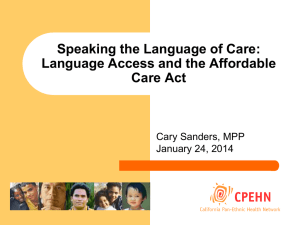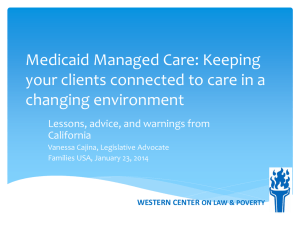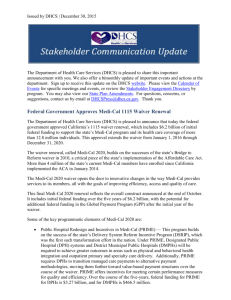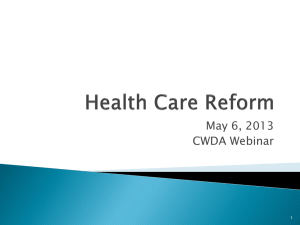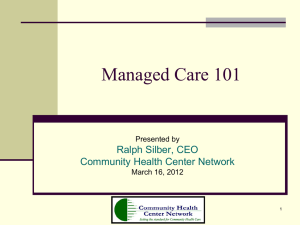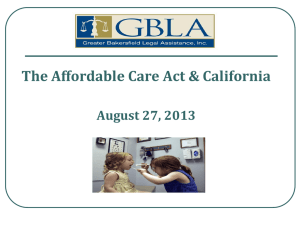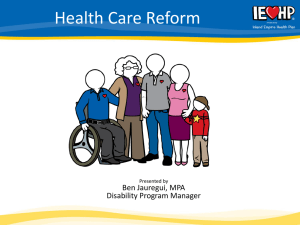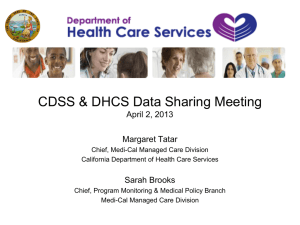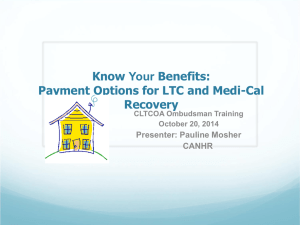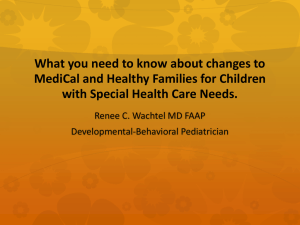Medi-cal strategic business analytics
advertisement
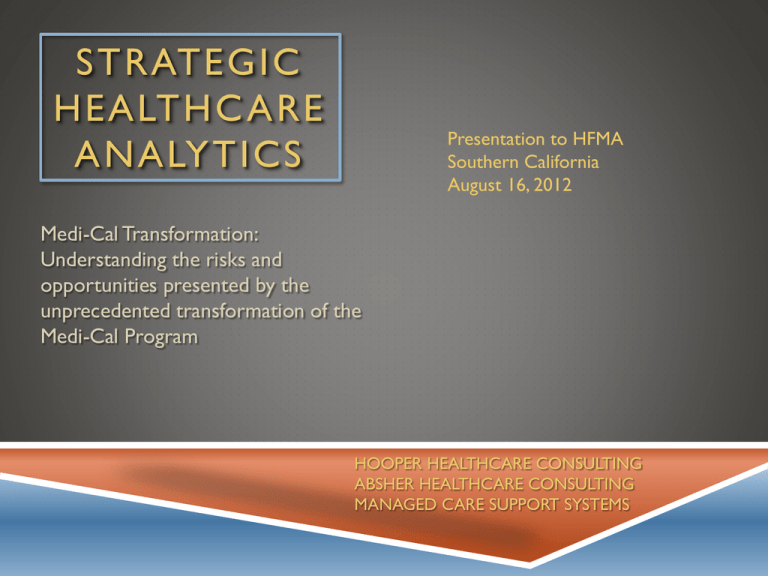
STRATEGIC HEALTHC ARE ANALYTICS Presentation to HFMA Southern California August 16, 2012 Medi-Cal Transformation: Understanding the risks and opportunities presented by the unprecedented transformation of the Medi-Cal Program HOOPER HEALTHCARE CONSULTING ABSHER HEALTHCARE CONSULTING MANAGED CARE SUPPORT SYSTEMS MEDI-CAL MANY MOVING PIECES Managed Care in Rural Areas SPD Enrollment in Managed Care Children’s Health Pilots Medi-Cal Transformation APRDRG Expansion to Managed Care FFS to APRDRG Dual Eligible Pilots AUGUST 1, 2012 2 MEDI-CAL MANY MOVING PIECES Other Key Items Related to Medi-cal Current Implementation of Low Income Health Program Medicaid Expansion in 2014 California Health Benefit Exchange Establishment of a Basic Health Plan for those between 133-200% of FPL? AUGUST 1, 2012 3 MEDI-CAL POPULATION RESPONSIBILITY 81% 80% 79% 78% 77% 76% 75% 74% 73% 72% Medi-Cal FFS Acute Days as a % of Total 2002 2006 2010 2002 2006 2010 Source: OSHPD Annual Financial Data Reports AUGUST 1, 2012 4 MEDI-CAL POPULATION RESPONSIBILITY DHCS indicates that 22% of acute Inpatient Days would shift to Managed Care as the patients are Classified as an Aid Code of Seniors and Persons with Disabilities. This is from 2009 Data Set Makes financial planning much more difficult than in years past to determine impact of the transition and financial planning related to Utilization The range across facilities of a percentage of SPDs varies widely from low of ~5% to high of 80% Managed Care to be expanded into rural counties, plus recent expansion between 2010-2012 in other counties. Currently Managed Care available in 28 counties AUGUST 1, 2012 5 CALIFORNIA MEDI-CAL FFS APRDRG APRDRG – All Patient Refined DRG Originally developed by 3M and National Association of Children’s Hospitals and Related Institutions 314 Base DRGs, with 4 levels of severity assigned 29 Base Neonate and Normal Newborn DRGs 12 Base Obstetrics DRGs Will require separate submission of mother and well baby claims No interim bills less than 30 days Discontinuation of daily TAR process Impact of Medi-Cal Recovery Audit Contractor Program? Contract Awarded in April 2012 Beginning Scope is limited, but could expand AUGUST 1, 2012 6 CALIFORNIA MEDI-CAL APRDRG Intended as a “budget neutral” payment method DSH and Supplemental funding excluded Elements of California’s APRDRG payment method DRG with national weights Wage index adjuster Outliers Policy Adjusters Rural designation – Adjustment – Attempt to hold harmless at 5% corridor for group AUGUST 1, 2012 7 CALIFORNIA MEDI-CAL APRDRG Program built based on 2009 database built by ACS/Xerox Required significant integration of multiple data sources to assign the DRG Will drive the financial exposure limits through transitional pricing corridors Significant assumptions made including the methodology for eliminating the SPDs from the database and the exclusion of claims without a discharge State will not update the data prior to implementation AUGUST 1, 2012 8 CALIFORNIA MEDI-CAL APRDRG Policy Adjusters 1.25 for Neonate, Pediatric Care 1.75 for Neonatal Care provided at a CCS Approved Neonatal Surgery NICUs DHCS has stated intent to monitor continued appropriateness of policy adjusters related to patient access Transfers No post-acute transfer adjustments Transfers to acute care subject to per diem based payment based on average length of stay AUGUST 1, 2012 9 CALIFORNIA MEDI-CAL APRDRG 4-year phased implementation beginning July 1, 2013 Financial exposure mitigation through transitional pricing corridors: +/- 5% maximum FY13-14 +/- 10% maximum FY14-15 +/- 15% maximum FY15-16 Full DRG payment FY16-17 and beyond AUGUST 1, 2012 10 DHCS DATABASE BUILDING BLOCKS 2009 Paid Claims Match to paid claims Provided diagnostic information All Medi-Cal FFS paid claims Excluded denials 2009 OSHPD Discharge File Assumptions Inferred newborn claims Exclusion of managed care eligible Exclusion of incomplete claims AUGUST 1, 2012 11 CRITICAL ANALYTICAL SHORTCOMINGS Inadequacy of data used to build the program and potential ramifications – Inaccurate Base Rate Setting Change in utilization of services since 2009 Limitations on losses or gains as a result of transition Key payment drivers (i.e., adjusters, outliers, wage index) Impact of moving large FFS populations to managed care Pilot enrollment of dual eligible population; prospects for expansion Rogers rate implications Adoption by managed care plans AUGUST 1, 2012 12 MEDI-CAL APRDRG DHCS DATASET Care Category % of Total Revenue – 2009 Fee-ForService Estimates <1% 4% OB & Nursery - 39% Neonate - 9% 33% 24% Circulatory adult - 8% Resp pediatric - 1% Resp adult - 5% Misc pediatric - 9% 9% Misc adult - 22% 9% 8% 10% 3% Gastroent adult - 7% Other <1% 48% of FFS Revenue will come from Obstetrics, nursery and neonatal care However a significant amount of care will still be delivered through the FFS system for adults and pediatric cases. AUGUST 1, 2012 13 STATE DATA VS. HOSPITAL DATA What changes in case mix and services rendered to Fee- For-Service beneficiaries occurred in subsequent years? State has signaled that they will not create databases for 2010, 2011, or 2012 Has there been any change in the Fee-for-Service population at a given hospital? AUGUST 1, 2012 14 HOSPITAL DATA: 2009 VS. 2010 Paid Claims Payment Amount 42,000,000 42,000,000 41,000,000 40,000,000 38,000,000 2009 2010 39,000,000 38,000,000 37,000,000 36,000,000 2009 2010 AUGUST 1, 2012 15 2009 APRDRG PRICING – NON SPDS 16,000,000 14,000,000 12,000,000 10,000,000 8,000,000 6,000,000 Historical Payments 4,000,000 Projected Payment Amount 2,000,000 - Critical to review services by Care Category to measure efficiencies, areas to improve in, and to consider adjusting AUGUST 1, 2012 16 CALIFORNIA MEDI-CAL APRDRG: MANAGED CARE Rogers Rate: Plans to pay out of network providers at DRG rates Plans to be paid based on projected expenses related to DRGs Plausible that plans will shift to DRG based payment Have seen this play out in other states Potential Implications? AUGUST 1, 2012 17 DUAL ELIGIBLE PILOT PROJECTS Dual Eligibles Who are they? There are 1.1 million dual eligibles in CA What services are they utilizing? What will be the impact on Utilization? DHCS projects a 20% decrease in inpatient utilization by dual eligible beneficiaries enrolled in Medi-Cal HMOs The state estimates $675 million in general fund savings in year 1 of demonstration AUGUST 1, 2012 18 DUAL ELIGIBLE PILOT PROJECT Implementation begins no earlier than March 2013 and no later than June 2013 CA plans to start with following 8 counties: Los Angeles, Orange, San Diego, San Mateo, San Bernardino, Riverside, Alameda and Santa Clara CMS has announced that they will likely limit Dual Pilots Nationwide to about 2 Million Enrollees (States have thus far proposed 3 Million Enrollees) Possibility that some counties may not proceed as anticipated given CMS statements and increasing political pressure Rate Setting and Contract Negotiations with plans September – October 2012 Beneficiary and Provider Outreach – October 2012-June 2013 AUGUST 1, 2012 19 DUAL ELIGIBLE PILOT PROJECT AUGUST 1, 2012 20 DUAL ELIGIBLE PILOT PROJECT What can hospitals do to monitor and act strategically? AUGUST 1, 2012 21 DUAL ELIGIBLE PILOT PROJECT: CALIFORNIA STATISTICS Medicare FFS Days 28% Dual Eligible Non-Dual 72% The initial enrollment will include 685,000 beneficiaries AUGUST 1, 2012 22 THE PERFECT STORM? Medi-Cal Managed Care Health Benefit Exchanges Changing Payor Mix Impact on Supplemental Funding Medi-Cal DSH Cuts Dual Eligible Pilots Medi-Cal Expansion Medicare DSH Cuts Medi-Cal DRG Quality Assurance Fee AUGUST 1, 2012 23 STRATEGIC HEALTHCARE ANALYTICS Our Industry is data rich, but we continue to face many challenges using data effectively With declining reimbursements, and growing demands from payers, effective, actionable analytics become all the more important Integrating and analyzing data from disparate systems/sources can be the key to creating useful analytics AUGUST 1, 2012 24 UTILIZING ANALYTICS •Projecting fiscal impact •DRG vs. HMO •Reimbursement •Workgroup input •Appeals process •Trade group input •Cost containment strategies •Data capture and coding Budgeting Operational Improvements Advocacy Strategic Planning •Service line specific analysis AUGUST 1, 2012 25 WHERE DO YOU GO FROM HERE? AUGUST 1, 2012 26 CONTACT INFORMATION Bryan Hooper Hooper Healthcare Consulting, LLC Email:bhooper@hhcllc.us.com Phone: (714) 871-3494 Matt Absher Absher Healthcare Consulting, LLC Email: matt@absherconsulting.com Phone: (530) 231-5305 AUGUST 1, 2012 27

